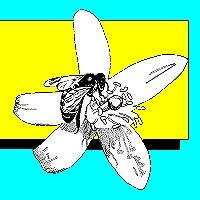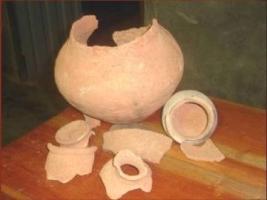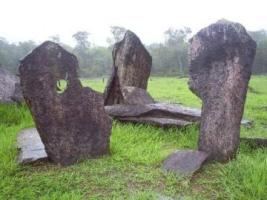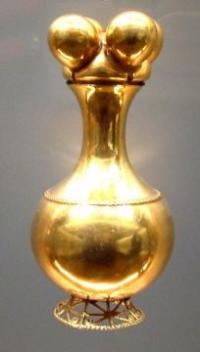APIS Volume 13, Number 11, November 1995

In this issue
- Screening for African Bees (AHB)
- AHB in California
- The Facts on Vine Pollination
SCREENING FOR AFRICAN BEES (AHB)
The Africanized Honey Bee Task Force, appointed by Bob Crawford, Commissioner of the Florida Department of Agriculture and Consumer Services, met October 11, 1995 at the Doyle Conner Building in Gainesville. A major reason for this was to begin consideration of Florida policy on African honey bee certification. According to Mr. Laurence Cutts, chief apiary inspector: "Since the African Honey Bee (AHB) movement east has currently stalled south of Houston, Texas, and natural migration into Florida may be many years away, it is more important than ever that man-assisted movement be prevented." According to Mr. Cutts, the department has been pro-active in setting up a bait hive line along I-10 and adding additional bait hives at ports of entry. Now it would like to prevent introduction using regulations that will not place an unbearable burden on the Department nor the beekeeping industry.
After some discussion, the Task Force recommended the following certification requirements for honey bees entering Florida:
- The Florida Department of Agriculture shall be notified as soon as possible, but no later than time of entry. Honeybee colonies will be certified on a first-come, first-serve basis. [Editor's note: Originally only bees from states determined to be Africanized were included. The Task Force, however, is now proposing that all honey bees entering Florida come under this provision.]
- A compliance agreement setting forth the following conditions must be signed by the owner/operator:
- A. The exact location of the drop (unloading) yard(s) will be given.
- B. The bees will be held in the drop yard(s) until certified by the Department to move.
- C. An inspector biased sample of 10 percent of the colonies will be checked.
- Should any sample be 90 percent probability or above of being AHB, the beekeeper has two options:
- A. Requeen immediately with certified European stock, be dequeened and stacked, or
- B. Wait for a sample to be sent to Gainesville for further testing. If 90% or above in Gainesville, it will be sent to Beltsville, MD.
- Any colony exceeding 100% probability of being AHB will initiate a 100% testing of that load.
- Any colony confirmed to be African must be requeened, dequeened and stacked, or destroyed within seven days of receipt of written notice.
- Package bees and queens must be certified by the state of origin.
It is anticipated that the testing will use a "fresh weight" system. This procedure is estimated to take about three minutes per sample. The sampling process is considered "special" within the context of Florida's Apiary Inspection services. As such, it carries a service charge based on time and travel expenses of inspectors.
I emphasize that the above are only recommendations at the present time. The final step will be forwarding them to the Agricultural Commissioner's office. This has been postponed, however, for another year by the Division. Reasons for the delay include the fact that the AHB has yet to reach the almond-growing area in California, that statistical justification for doing a percentage inspection is weak and finally, that resources to do 100 percent inspection do not exist in the Division. Now that this has been put off for the time being, there is some breathing room to contemplate the effects of these possible regulations on individual beekeepers and regulators. If you have questions or concerns, contact your local bee inspector or Mr. Laurence Cutts, Chief Apiarist, P.O. Box 147100/1911 SW 34th St., Gainesville, FL 32614- 7100, ph 904/372-3505 or fax 904/955-2301.
AHB IN CALIFORNIA
In the February 1990 APIS, I reported on the pioneering honey bee DNA work of Dr. Glenn Hall here in the Entomology and Nematology Department. In the journal Nature (1989), he concluded that a predominance of maternally inherited mitochondrial DNA in African bees suggested the insects were spreading by swarming, rather than through genetic inheritance from drones. In the July 1994 APIS, I reviewed the results of a study in the journal Experientia by N.M. Schiff and W.S. Sheppard that tracked bee ancestry using mitochondrial DNA. The same issue also discussed possible reasons why the AHB migration had slowed considerably in Texas and was rapidly spreading westward, but not towards the east as fast as predicted. Dr. Robert Page, at the University of California, Davis, adds to the story in From the U.C. Apiaries, July/August 1995, published by Dr. Eric C. Mussen:
"Africanized honey bees were first detected in California last fall when they suddenly appeared at a prison near Blythe. Since then, a total of ten colonies has been detected, two near Blythe and the rest in the Imperial Valley. Most of these colonies were determined to be Africanized on the basis of the USDA-ID morphometric method that analyzes 21 different size and body part characteristics. In addition to the standard USDA-ID method, the California Department of Food and Agriculture pest diagnostic lab analyzed the mitochondrial DNA of these bees using a technique developed in my laboratory by Dr. Paul Ebert. [Editor's note: This is based on a method published by Dr. Hall in the Proceedings of the National Academy of Sciences (1991).] They found that all of these colonies had African-type mitochondria. The mitochondria in honey bees (and humans) is inherited only from the mother. Therefore, these results demonstrate that the Africanized bees arriving in California are part of a very long maternal line that extends relatively unchanged back to the original introduction of African bees in Brazil in 1956. [Editor's note: This was also concluded by Dr. Hall in his Nature study mentioned above.]
"Two years ago Africanized bees were found on the southern and eastern borders of California. I believed at that time that their entry into California was inevitable and had probably already occurred. My hypothesis was that they would increase in density in that area until they were numerous enough to be captured in a trap, or cause some kind of problem in an inhabited area. The repeated finds of Africanized bees in the Imperial Valley this spring stimulated me to sample bees from that region in order to determine their distribution and relative abundance.
"The standard USDA-ID method requires sampling 10 bees from a single colony. Feral colonies are not easily found unless they fly into traps or are a nuisance to someone, so the morphometric method is not good to use as a random survey tool. Mitochondrial DNA analyses, however, can be made on single bees. Therefore, an area survey is possible by simply catching bees on flowers, then determining their mitochondrial type. If Africanized bees are abundant in an area, relative to European bees, then there should be an abundance of African mitochondrial types in the sample.
"April 13-15, I (along with my 11-year-old son, Brian) collected 75 bees from 31 collection sites located in the Imperial Valley and near Blythe, California. We tried to make collections in areas where the bees were likely to be feral, although there is no way to tell where the bees came from. Mitochondrial DNA diagnostics were run on these bees and we did not find any mitochondrial types that are indicative of Africanized honey bees. I interpret these results to suggest that Africanized honey bees are not yet abundant in these areas.
"My original hypothesis was probably wrong. Africanized bees have not been in California for two years; it is likely that we are truly seeing the very early stages of the 'invasion' of Africanized bees. The current method of sampling used by the California Department of Food and Agriculture--trap lines and reports from concerned citizens--are better than random sampling methods for early detection of rare Africanized colonies. However, the method of randomly sampling bees and checking their mitochondrial DNA will be the best indicator of the extent of 'Africanization' in an area.
"Why it has taken the bees so long to move into California and why they are spreading so slowly remain a mystery. [Editor's note: see possible reasons in the July 1994 APIS.] Genetic mixing with commercial bees does not seem to be the answer because the colonies that have been detected have been highly Africanized both in morphometric characters and mitochondrial DNA. [Editor's note: Dr. Hall published evidence in the Journal Genetics (1990) that feral Mexican honey bees of African descent had not hybridized significantly with commercial European bees. Also see June 1993 APIS on why hybrids may not persist in the wild.] Only time will tell to what extent they will spread and how abundant they will become, but for now they have not made a detectable impact, even in the Imperial Valley."
As time passes, therefore, the African honey bee migration continues to confound as it has almost from its date of release into the Brazilian wilds. And for those closest to the issue, one of the greatest biological events of the 20th century only becomes more and more intriguing. Unfortunately, this is often little solace to the general public and beekeeping industry in search of definite answers to cope with challenges posed by this remarkable insect.
THE FACTS ON VINE CROP POLLINATION
This second annual Florida Agricultural Conference and Trade Show (FACTS) at the Orange County Convention Center, October 24-26, 1995, was a rousing success by most measures. There was plenty to satisfy all those interested in the changing face of Florida agriculture. These included concurrent presentation on vegetables and citrus, a large trade show and several other exhibits, including one on how information technology is helping agriculture.
In previous conferences of this kind, I have noticed that pollination issues did not seem to have the same emphasis as those involving fertilization rates, disease and pest diagnoses, and pesticide applications. There are signs that this is changing, however. My presentation on "Pollination Requirements of Vine Crops" was well received and generated many more questions than usual, not only about honey bees, but also other pollinators. A few beekeepers were also in attendance hawking their pollination wares. And several exhibitors were selling chemical attractants to growers anxious to get more honey bees visiting target crops.
Increasing interest in pollination has brought with it the realization that much more needs to be learned about this aspect of Florida cropping systems. Information given at the vegetable session, for example, was wide ranging, but little was mentioned, even in passing, of pollination requirements. Production trials on a bewildering array of watermelons and discussion of the growing specialty vegetable crop market (pepper, garlic, artichoke, leek, chicory and others) dominated the agenda. The use of transplants instead of seed for seedless watermelon production (which require insect pollination in any case) and protected growing (greenhouses, plastic-sheeted frames) situations were also addressed during the vegetable session.
Taken as a whole, the FACTS convention produced a good deal of information important to those engaged in Florida citrus and vegetable culture. As part of their communication with customers, would-be commercial pollinators should also become conversant with the above topics and other aspects of the production techniques growers use (see July and October 1995 APIS). A copy of the vegetable proceedings, which includes the paper on vine crop pollination requirements, is available from Citrus and Vegetable Magazine, 794 N. 56th St., Suite 560, Tampa, FL 33617, ph 813/980-6386, fax 813/980-2871 or Dr. Don Maynard, Gulf Coast REC, 5007 60th St. E., Bradenton, FL 32403-9324, ph 813/751-7636, fax 813/751-7639.
Sincerely,
Malcolm T. Sanford
Bldg 970, Box 110620
University of Florida
Gainesville, FL 32611-0620
Phone (904) 392-1801, Ext. 143 FAX: 904-392-0190
INTERNET Address:MTS@GNV.IFAS.UFL.EDU
APIS on the World Wide Web--
http://gnv.ifas.ufl.edu/~entweb/apis/apis.htm
Copyright (c) M.T. Sanford 1995 "All Rights Reserved"




















